Fall 2021 - Winter 2022: Apply by September 1st
Digital technology is all around us, but often invisible. There’s little transparency about what data these technologies are collecting, by whom, and for what purposes. We’ve also seen that much technology in the built environment lacks controls for people.
We’ve drafted a standard that enables transparency, accountability, and control for people.
Join Helpful Places, Digital Public Square, the Office of New Urban Mechanics, City of Boston, and other contributors.
We want to help people increase their awareness of how digital technology in physical spaces works and give them avenues to learn more or follow up.
People may want to know about what data is being collected around them, but they also might want to know how to use that data or even to make better use of the environment itself. How might signage be a starting point for helping people better navigate and utilize their surroundings?
More signs are often not the answer. As visual noise increases, less meaningful information actually gets across. We want to develop a way to know whether signage or channels are working for people; we need that feedback so we can improve the design over time.
We know this is just an initial take, and we intend for others to build on this work.
We are in a unique position to consider how people move from a digital to a physical medium and back. This transition should feel useful and coherent.
In 2019, experts came together in cities around the world in co-design sessions to collaborate and prototype an initial set of open communication standards for digital transparency in the public realm. In 2020, this initial draft was refined through several cycles of online expert charrettes and small meetings, iterative prototype development, and longitudinal inclusive usability and concept testing. These draft standards, as well as all the co-design activities and materials that generated them, are publicly and freely available for others to adopt, use, and build upon.
A standardised way to describe sensors and convey what kind of data and processing they’re performing.
A standard way to describe systems within places, and what sensors, processing, and purposes they serve.
A vision for how agency and control can become part of everyday routines that are supported by digital technologies.
The core of the DTPR communication standard is a taxonomy of concepts around digital tech and data practices, and a set of icons to quickly and clearly communicate those concepts. These components can then expressed in a number of ways - from physical signage to digital channels for communication – which together, help visualize and convey how a digital system works.
You can find the materials used to support the development of this project here
The Icons, Design Guide and Taxonomy for DTPR are licensed by the Digital Transparency in the Public Realm contributors under the Creative Commons Attribution 4.0 International (CC BY 4.0). Portions of the DTPR Icons incorporate elements of, or are derived from, the Material icons. The Material icons are available under the Apache License 2.0. The source code for the Digital Channel Prototype is licensed under Apache License 2.0. Sidewalk Labs trademarks and other brand features within these works are not included in this license.
| Icon | Purpose | Description |
|---|---|---|
|
|
Enforcement | Used for enforcement of rules or regulations. Find out more here |
|
|
Energy Efficiency | Reduces energy use and/or helps conserve energy. Find out more about energy efficiency and energy conservation |
|
|
Mobility | Supports how people and materials move around. Find out more here |
|
|
Inform | Supports the provision of information, for example about a location, a service, or to provide assistance |
|
|
Planning & Decision-making | Supports the development of future plans; or to enable or measure the impact of a decision. Examples include urban planning |
|
|
Safety & Security | Enables a safe and/or secure environment, for example for the purposes of fire safety, home security or ensuring safe passage in places such as airports or roads |
|
|
Accessibility | Ensures that everyone has equal access to a space or a service. Find out more about accessibility and universal design |
|
|
Ecology | Supports the measurement or monitoring of the natural environment. Find out more about the natural environment, ecology and environmental science |
|
|
Waste Management | Supports the handling and disposal of waste, including as recyclables, compost and [hazardous materials] (https://en.wikipedia.org/wiki/Hazardous_waste}. Find out more about waste management |
|
|
Water Efficiency | Reduces water use and/or helps conserve water. Find out more about water efficiency and conservation, and green infrastructure. |
|
|
Fire & Emergency | Supports services that ensure public safety and health related to emergencies. Find out more about emergency services. |
|
|
Health | Supports the measurement or monitoring of the aspects of the physical environment that impacts human health, such as radiation or air quality, or in specific contexts such as the workplace. Find out more about environmental monitoring and occupational health and safety |
|
|
Agency & Interaction | Enables you to control or interact with aspects of a space or a technology. Find out more about interactive media and virtual reality |
|
|
Switch | Supports a mechanical function - such as turning a device on or off, opening or closing, or adjusting brightness and intensity. |
|
|
Research & Development | Supports exploratory research and testing. Find out more here |
|
|
Entry | Supports authentication or validation in order to access a space or a service. Find out more here |
|
|
Arts & Culture | Enables artistic and/or cultural expression. Find out more here |
|
|
Connectivity | Enables connectivity of devices to a digital network. Find out more here |
|
|
Logistics | Supports the movements of goods or materials. Find out more here |
| Icon | Technology | Description |
|---|---|---|
|
|
Video camera | Collects video footage. Find out more here. |
|
|
Video camera - infrared | Collects video footage in the infrared portion of the electromagnetic spectrum. |
|
|
Still camera | Collects still images. Find out more about cameras here |
|
|
Still camera - infrared | Collects still images in the infrared portion of the electromagnetic spectrum. |
|
|
Assistance Station | Provides access to assistive services. Examples include assistive technologies and virtual assistants |
|
|
Microphone | A device that collects audio. Find out more here |
|
|
Passive Infrared Sensor | An electronic sensor that measures infrared (IR) light radiating from objects in its field of view. Find out more here |
|
|
Soil Moisture Sensor | Soil moisture sensors measures the water content in soil. Find out more here |
|
|
Water Quality | Measures various aspects of water quality, such as the amount of dissolved oxygen in water, pH, nitrates and dissolved oxygen. Find out more here |
|
|
Sound Level Meter | Takes acoustic measurements, most typically for measuring noise pollution. Find out more here |
|
|
Radar | Uses radio waves to detect objects, or measure how they are moving through a space, such as vehicles. Find out more here |
|
|
LiDAR | Uses lasers to measure distances to objects, collecting data that can create a 3-D representation of the object. Find out more here |
|
|
Air Quality | Measures various aspects of air quality, such as pollen, particulate matter, ozone, and greenhouse gases. Find out more here |
|
|
Weather Station | A set of instruments for measuring atmospheric conditions such as temperature, precipitation, wind speed and direction, and barometric pressure. Find out more here |
|
|
Wireless Access Point | Provides wireless access to a wired computer network, or to the internet. Find out more here |
|
|
RFID | Enables the identification of items using electromagnetic fields, commonly used to track inventory in stores, but not for identifying individual items. Find out more here |
|
|
NFC | A wireless communication protocol for electronic devices that are within a short distance of each other, typically used in ticketing or payment systems. No identifying data is collected in this case. Find out more here |
|
|
Weighing Scale | A weighing scale is a device to measure weight or mass. No identifying data is collected in this case. Find out more here |
|
|
Thermometer | Measures the temperature of or changes of temperature in the physical environment, and quantifies those attributes according to a standardized scale such as Celsius or Fahrenheit. Find more more here |
|
|
Identifiable NFC | A wireless communication protocol for electronic devices that are within a short distance of each other, typically used in ticketing or payment systems. In this case, unique identification is possible, for example if a particular item is closely associated with an individual's personal data. Find out more here |
|
|
Identifiable RFID | Enables the identification of items using electromagnetic fields, commonly used to track inventory in stores. In this case, unique identification is possible, for example if a particular item is closely associated with an individual's personal data. Find out more here |
|
|
Identifiable Video | Collects video footage of a sufficient resolution where individuals can be identified, for example by capturing images of faces or unique numbers such as vehicle license plates. Identifying information can be collected either through manual review by a person, or through computer vision techniques that derives information in the form of data from video or images. |
|
|
Identifiable Voice | Audio data is collected that does or can identify individuals, either through manual review or by technologies that can determine either what is being said, or who is saying it. Find out more about speech recognition or speaker recognition. |
|
|
Identifiable Image | Collects still images of a sufficient resolution where individuals can be identified, for example by capturing images of faces or unique numbers such as vehicle license plates. Identifying information can be collected either through manual review of images by a person, or through computer vision techniques that derives information in the form of data from images. |
|
|
De-identified Video | Collects video footage of a sufficient resolution where individuals can be identified, for example by capturing images of faces or unique numbers such as vehicle license plates. However, the video is processed in a way that removes identifying characteristics before it is used or stored (known as de-identified before first use or de-identified on device), for example by blurring faces using computer vision. Find out more about de-identification |
|
|
De-identified Image | Collects still images of a sufficient resolution where individuals can be identified, for example by capturing images of faces or unique numbers such as vehicle license plates. However, images are processed in a way that removes identifying characteristics before it is used or stored (known as de-identified before first use or de-identified on device), for example by blurring faces using computer vision. Find out more about de-identification |
|
|
De-identified Voice | Audio data is collected that does or can identify individuals, either through manual review or technologies that can determine either what is being said, or who is saying it. Find out more about speech recognition or speaker recognition. Data is processed in a way that removes identifying characteristics before it is used or stored (known as de-identified before first use or de-identified on device). Find out more here |
| Icon | Technology | Description |
|---|---|---|
|
|
Values / Time | Measurements that are collected at regular intervals over a period of time. For example see [time series data] (https://en.wikipedia.org/wiki/Time_series). |
|
|
Pixel-based Image | A digital image is composed of a grid of individual pixels. Find out more at [digital image] (https://en.wikipedia.org/wiki/Digital_image) |
|
|
Boolean | Data that has one of two data values, for example true and false. Find out more [here] (https://en.wikipedia.org/wiki/Boolean_data_type) |
|
|
Tabular | Data that is stored in a table, where values are stored in rows and columns. More [here] (https://en.wikipedia.org/wiki/Table_(information)) |
|
|
Spatial | Data that represents a location, such as an address, a place name or geographic coordinates; or a structure, such as a floorplan. Find out more about [geospatial data] (https://en.wikipedia.org/wiki/Geographic_data_and_information) and [building information models] (https://en.wikipedia.org/wiki/Building_information_modeling) |
|
|
Binary | Compressed data into a binary format. Find out more [here] (https://en.wikipedia.org/wiki/Binary_file) |
| Icon | Technology | Description |
|---|---|---|
|
|
RDUA Approved | Data activity has undergone a Responsible Data Use Assessment and determined to provide a net benefit. The RDUA is a process that Sidewalk Labs conducts prior to the start of any data activity. |
|
|
Reviewed Internally | "Many organizations have internal review processes that consider the potential benefits, risks and implications for privacy for new technologies or data collection activities. For example, in Canada, Privacy Impact Assessments are often conducted by organizations prior to the beginning for a project - find out more [here] (https://en.wikipedia.org/wiki/Privacy_Impact_Assessment). This could be customized with the details of the accountable entity responsible for these instances of technology in the public realm |
|
|
Encrypted | Data has been encoded so that only authorized parties can access it, which can reduce risk related to handling private or sensitive information. Find out more [here] (https://en.wikipedia.org/wiki/Encryption) |
|
|
Aggregated | "Data that has been grouped or summarized from individual measurements, for example to count up totals or to calculate an average. Find out more [here] (https://en.wikipedia.org/wiki/Aggregate_data) |
|
|
Raw data | "Data that has not been processed or altered from the point of collection - the data is effectively identical to how it was gathered from the original data source. Find out more [here] (https://en.wikipedia.org/wiki/Raw_data) |
|
|
Regulated | Depending on the jurisdiction and type of data, data is regulated in various ways. For example, Personal Information in Canada is regulated by federal, provincial, and municipal laws. The collection, use and disclosure of Personal Information by private companies in Ontario is regulated by the [Personal Information Protection and Electronic Documents Act] (https://www.priv.gc.ca/en/privacy-topics/privacy-laws-in-canada/the-personal-information-protection-and-electronic-documents-act-pipeda/) This should be customized for the jurisdiction where this digital channel is being used |
|
|
AI System | Data that is processed by automated, algorithmic or artificial intelligence systems to derive a new result or data point. Find out more about [automated] (https://en.wikipedia.org/wiki/Automated_decision_support), [algorithmic] (https://en.wikipedia.org/wiki/Algorithm) and [artificial intelligence] (https://en.wikipedia.org/wiki/Artificial_intelligence) systems. |
|
|
De-identified | Data that is processed to remove identifying values, usually to protect privacy. De-identification can happen at any point in a data collection process, for example before it is stored in a database, or before it is published. Here we define it to mean after the data has already left a hardware device, or after it has been stored in a database. Find out more [here] (https://en.wikipedia.org/wiki/De-identification) |
| Icon | Technology | Description |
|---|---|---|
|
|
Available to download | Data that can be accessed and downloaded online, either for free or for a fee |
|
|
Available to 3rd parties | Data is available to 3rd parties not involved in the data activity. This does not always mean that data is being resold. |
|
|
Available to me | Available to me but not to other individuals. For example, as an individual you have access to all your electronic toll records for your car, but other individuals do not have access to that. |
|
|
Not available to me | Not available to me or other individuals. As an individual, there isn't a way for you to access this data. |
|
|
Available for resale | The data collected may be resold to other 3rd parties |
|
|
Not available to the accountable organization | Data is not available to the accountable organization this can be customized |
|
|
Not available to vendor | Data is not available to the data collection or technology provider this can be customized |
|
|
Available to the accountable organization | Data is available to the accountable organization this can be customized |
|
|
Available to vendor | Data is available to the data collection or technology provider this can be customized |
| Icon | Technology | Description |
|---|---|---|
| Stored on 3rd Party Cloud | Data is stored on behalf of the organization or the data collector in an off-site data centre, such as Amazon Web Services, Google Cloud and Microsoft Azure | |
|
|
No data retained | No data is kept or stored |
|
|
Retained 24 hours | Data is stored for 24 hours, and after this time period is deleted |
|
|
Retained 1 month | Data is stored for 1 month, and after this time period is deleted |
|
|
Retained 3 months | Data is stored for 3 months, and after this time period is deleted |
|
|
Retained for time period | Data is stored for a customized time period, and after this time period is deleted |
|
|
Retained 1 year | Data is stored for 1 year, and after this time period is deleted |
|
|
Retained 5 years | Data is stored for 5 years, and after this time period is deleted |
|
|
Retained indefinitely | Data is retained indefinitely |
|
|
Stored locally | Data is stored in the jurisdiction where it was collected. Find out more [here] (https://en.wikipedia.org/wiki/Data_sovereignty) |
|
|
Stored primarily locally | Data is stored mainly in the jurisdiction where it was collected. Find out more [here] (https://en.wikipedia.org/wiki/Data_sovereignty) |
|
|
Stored primarily internationally | Data is stored outside the jurisdiction where it was collected. Find out more [here] (https://en.wikipedia.org/wiki/Data_sovereignty) |
|
|
Backed up locally | Data is backed up with the jurisdiction where it was collected. Find out more [here] (https://en.wikipedia.org/wiki/Data_sovereignty) |
|
|
Backed up internationally | Data is backed up outside the jurisdiction where it was collected. Find out more [here] (https://en.wikipedia.org/wiki/Data_sovereignty) |
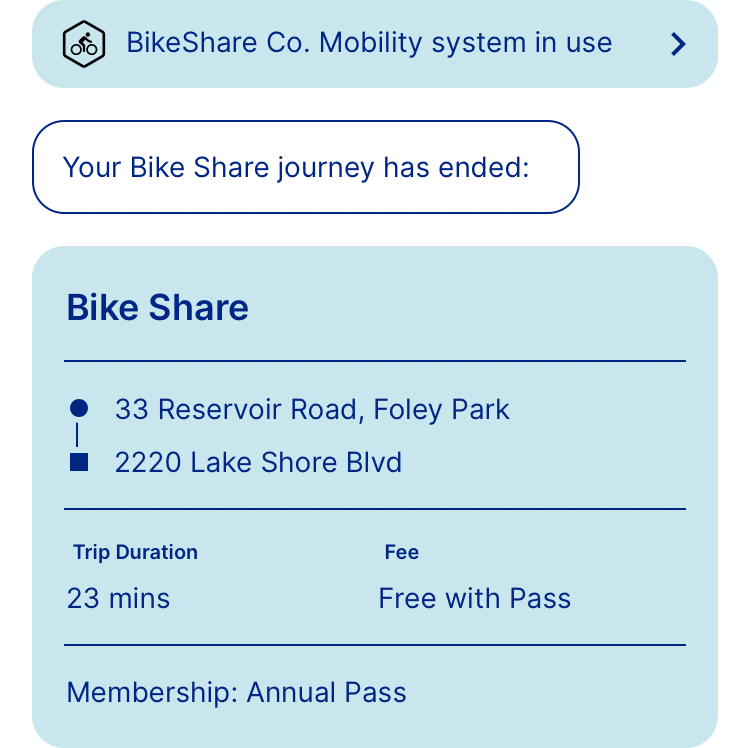
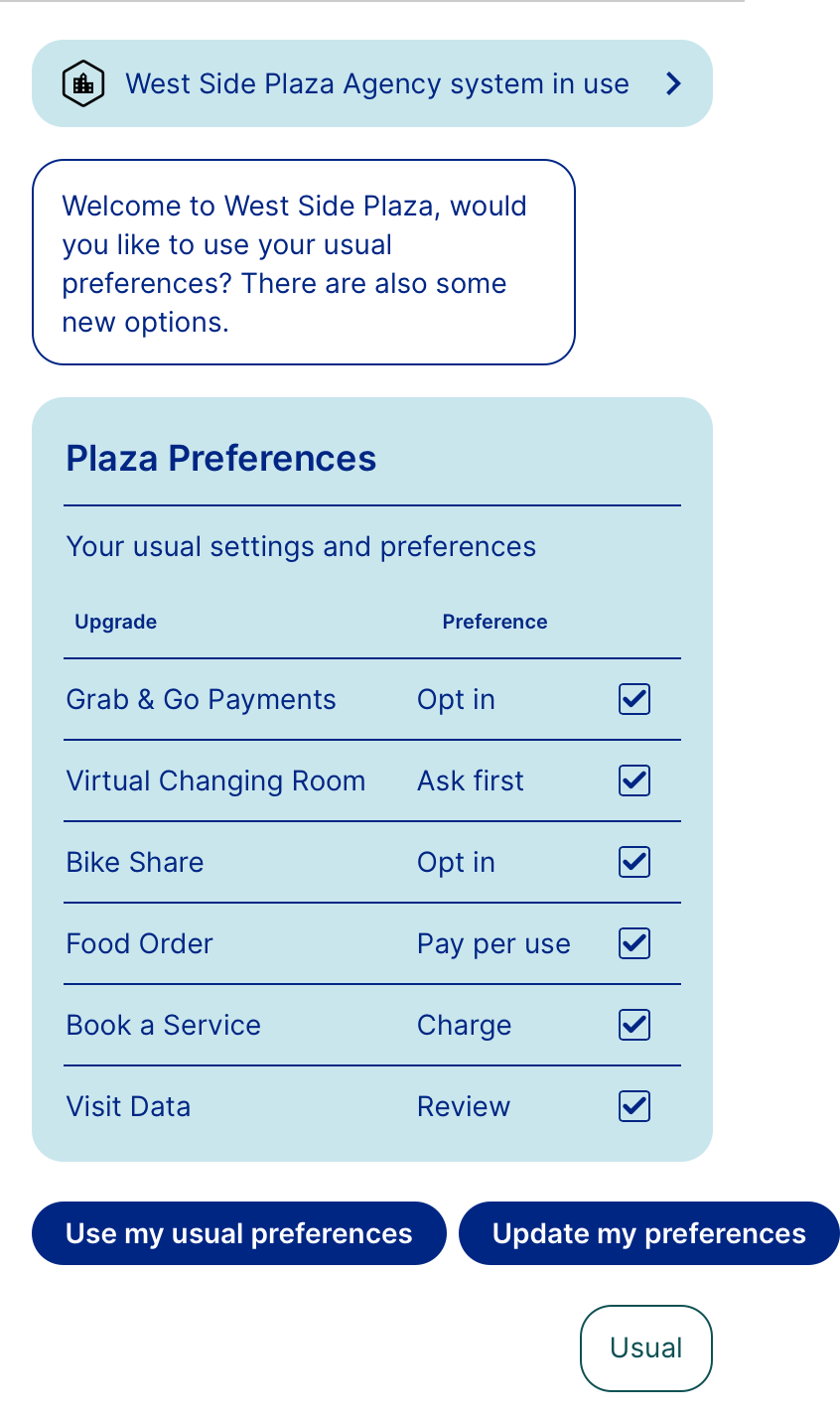
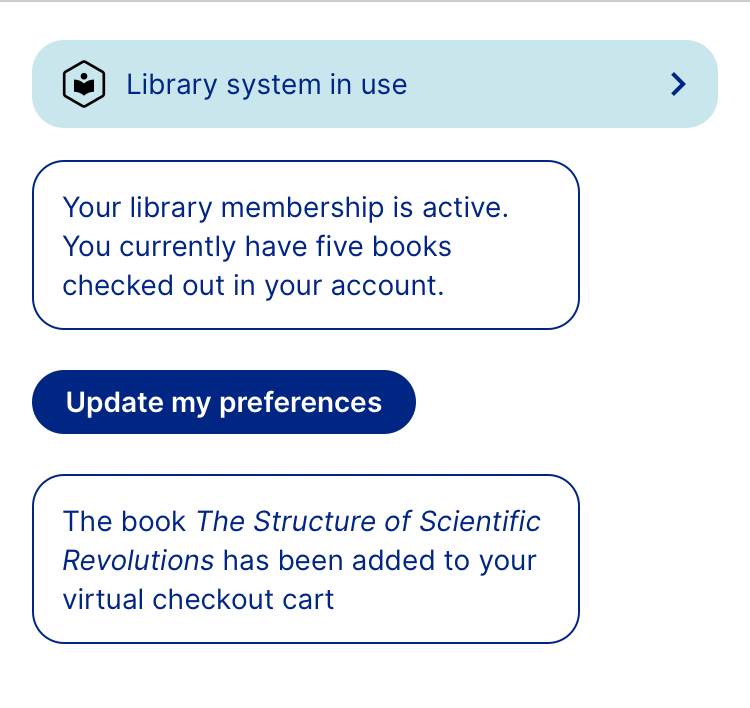
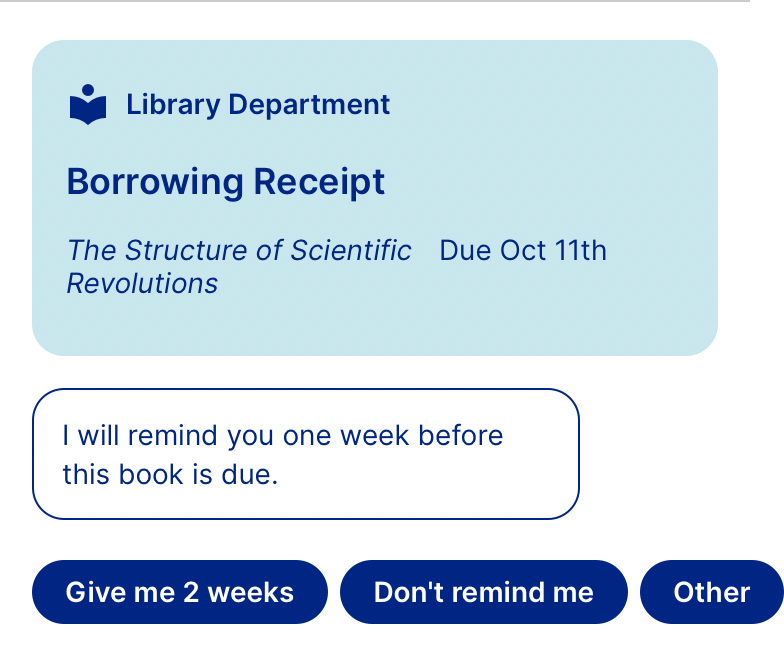
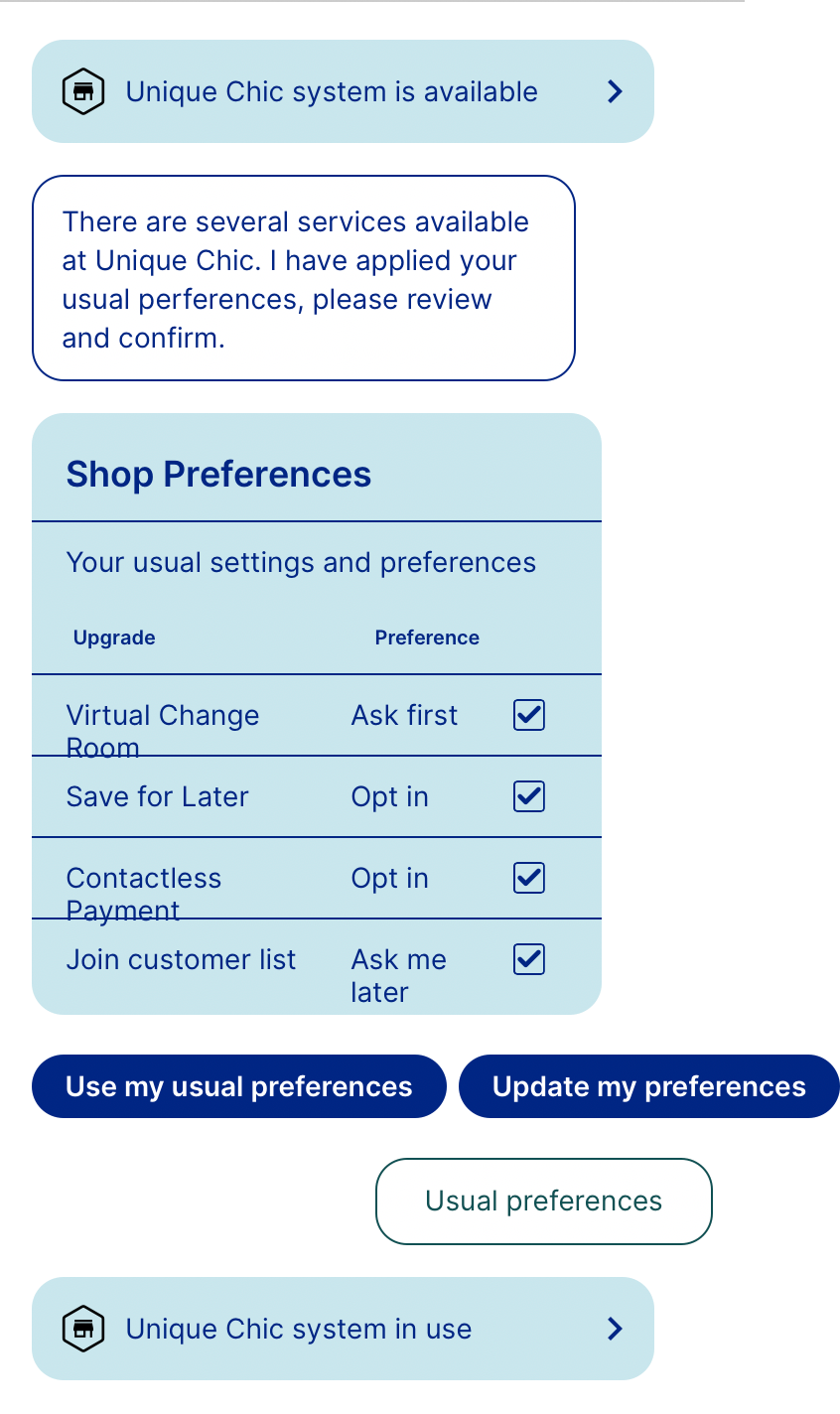
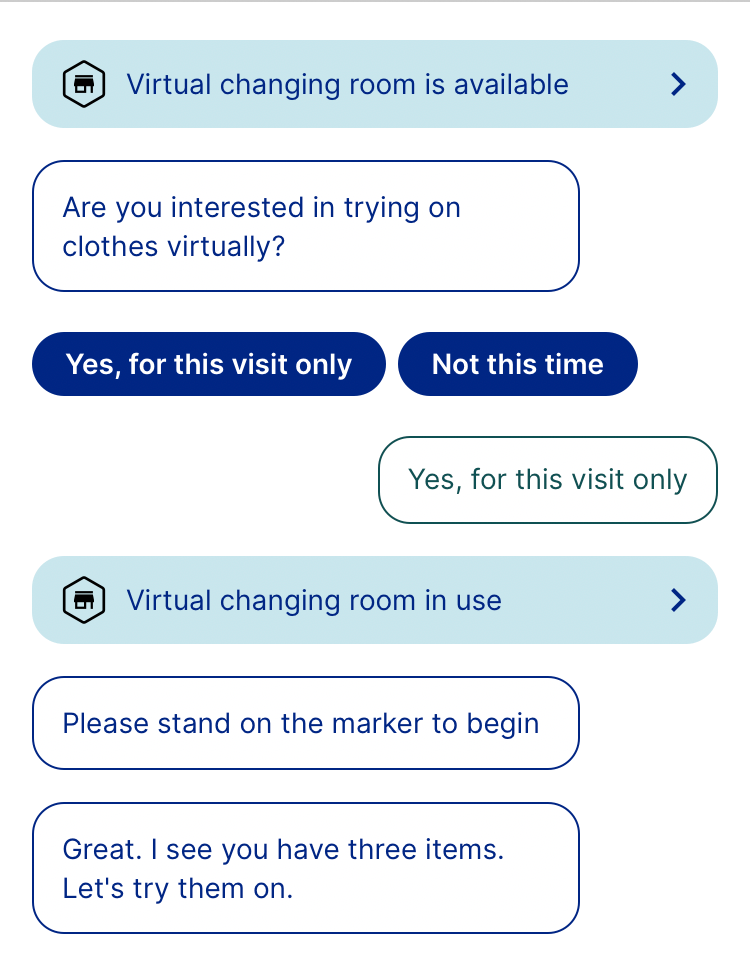
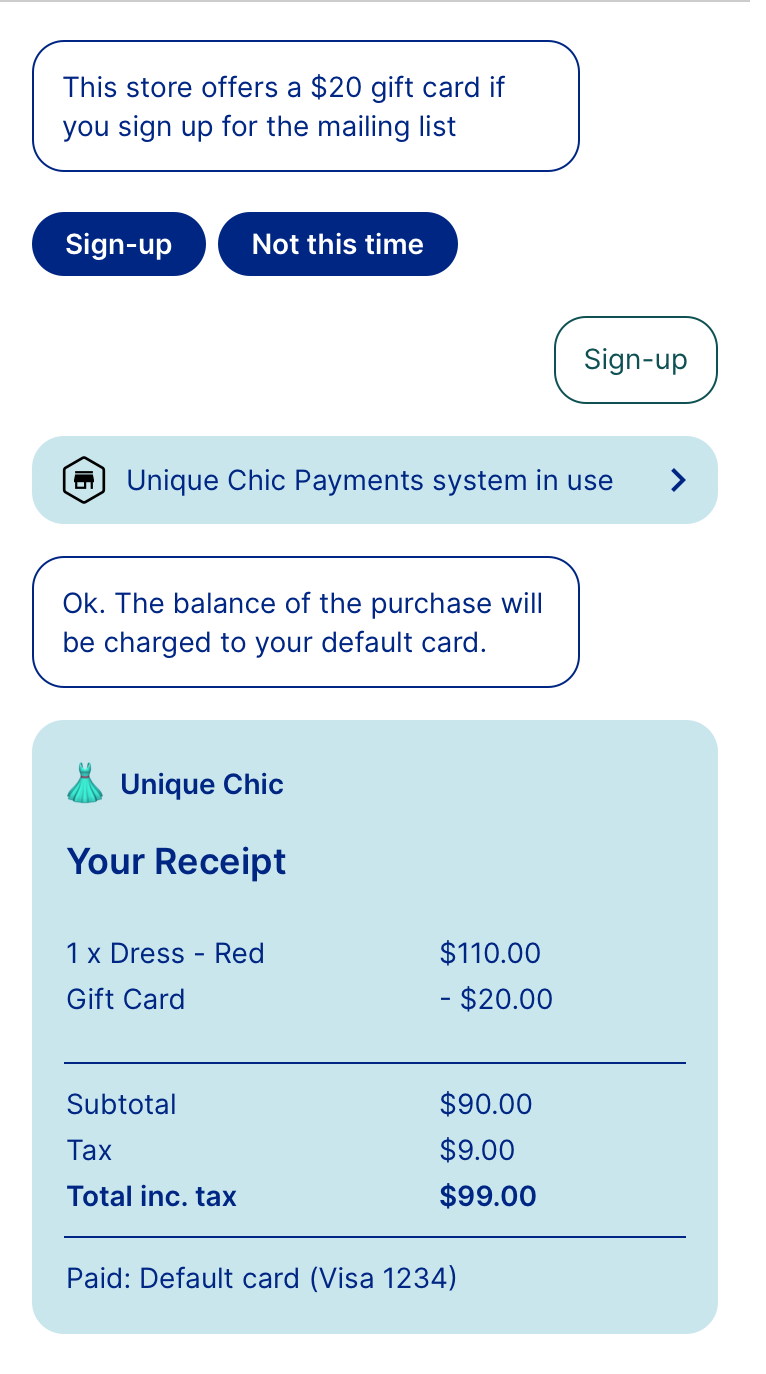
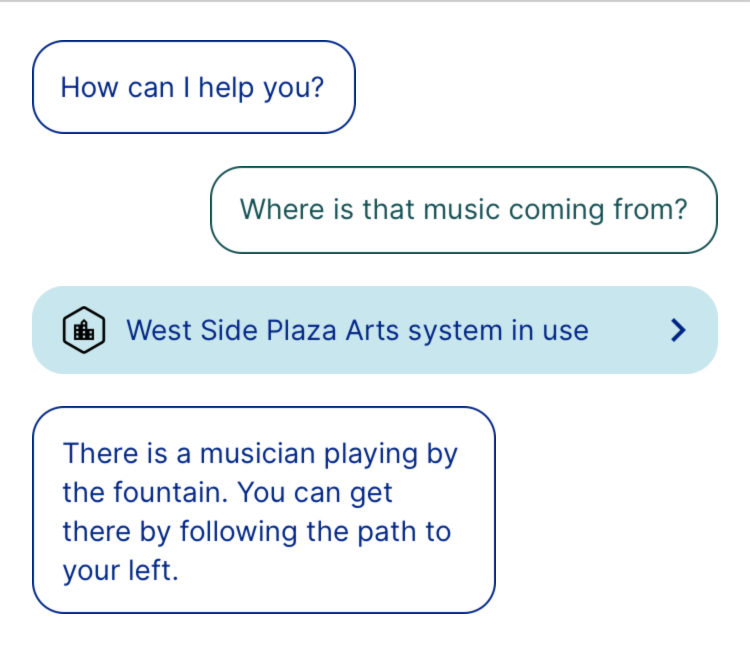
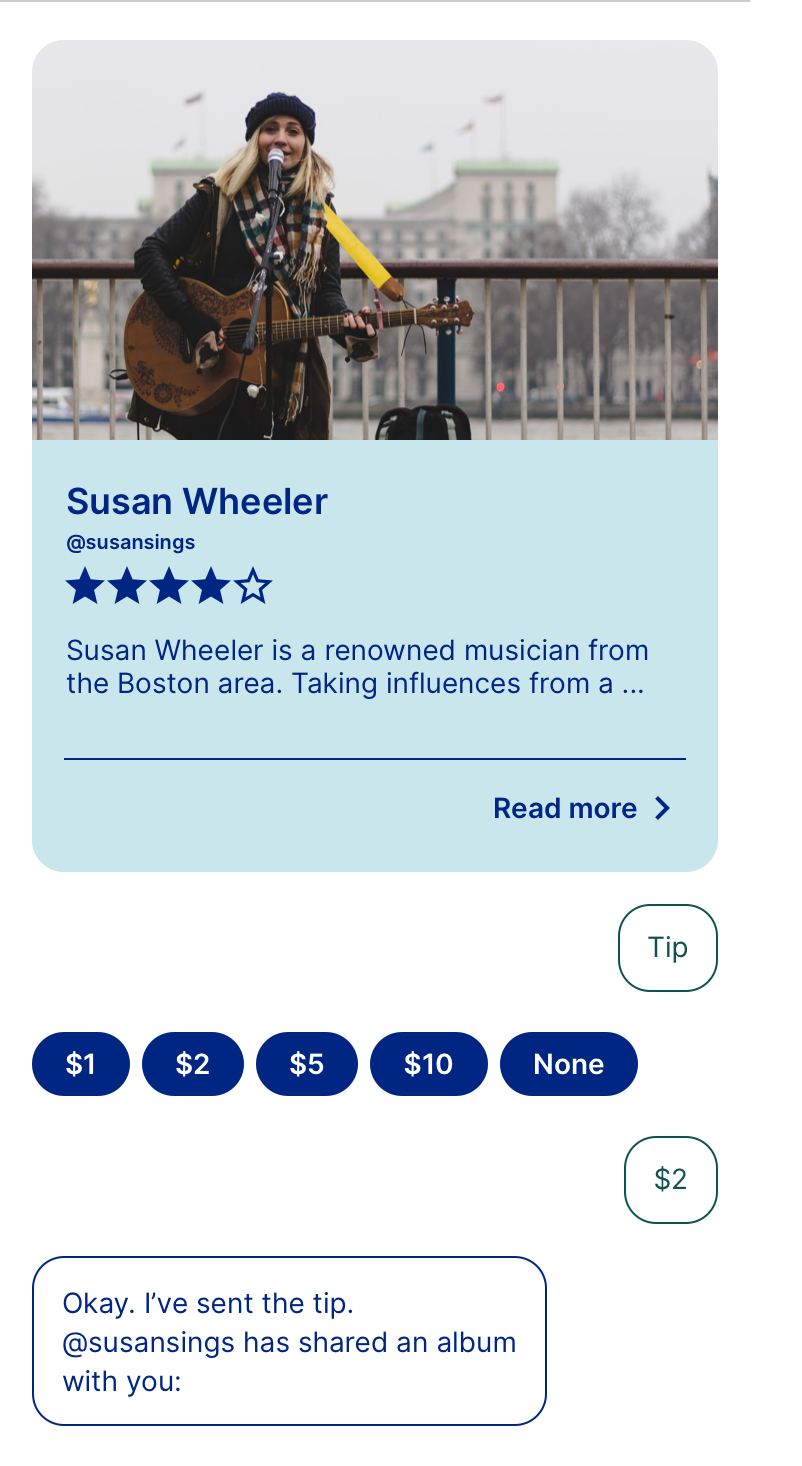
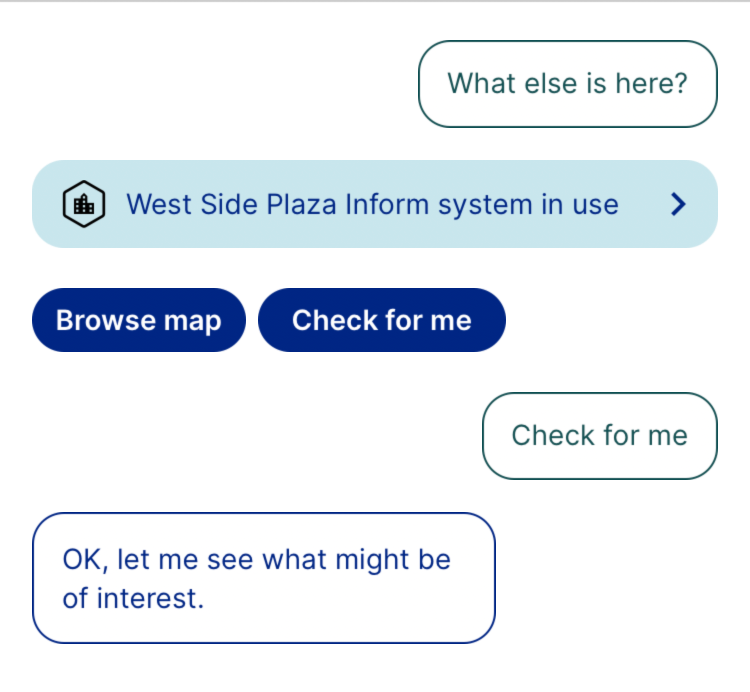
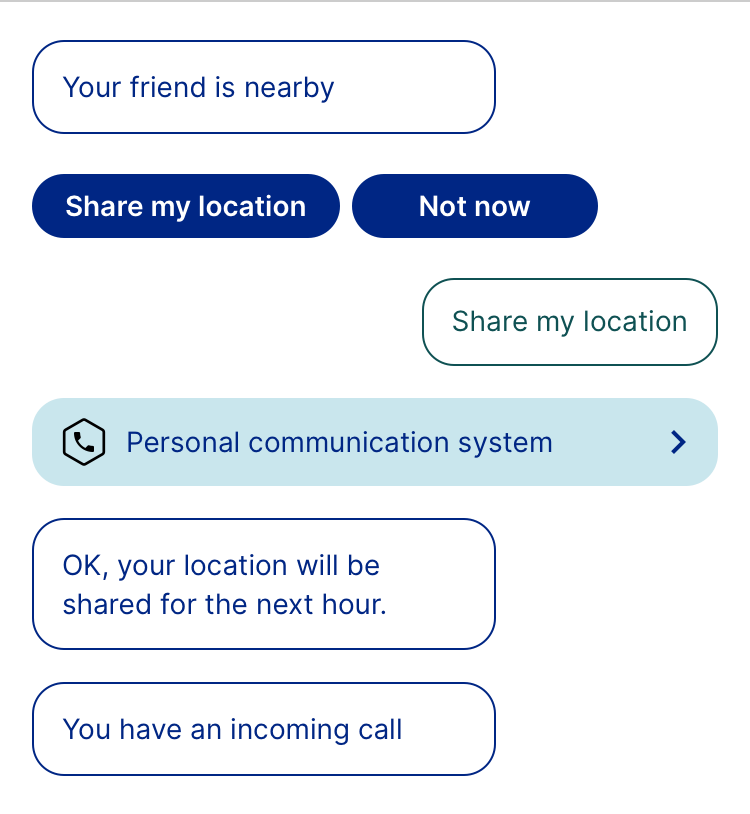
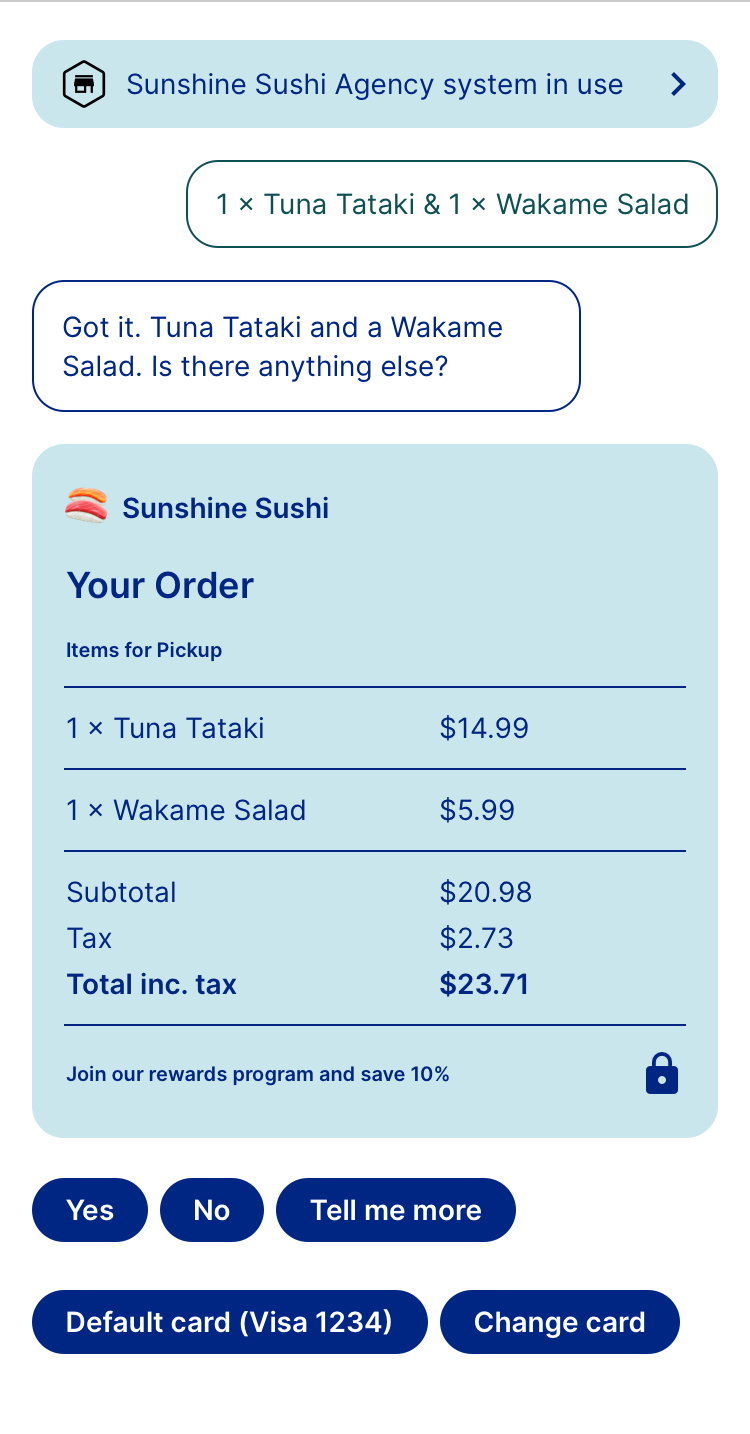
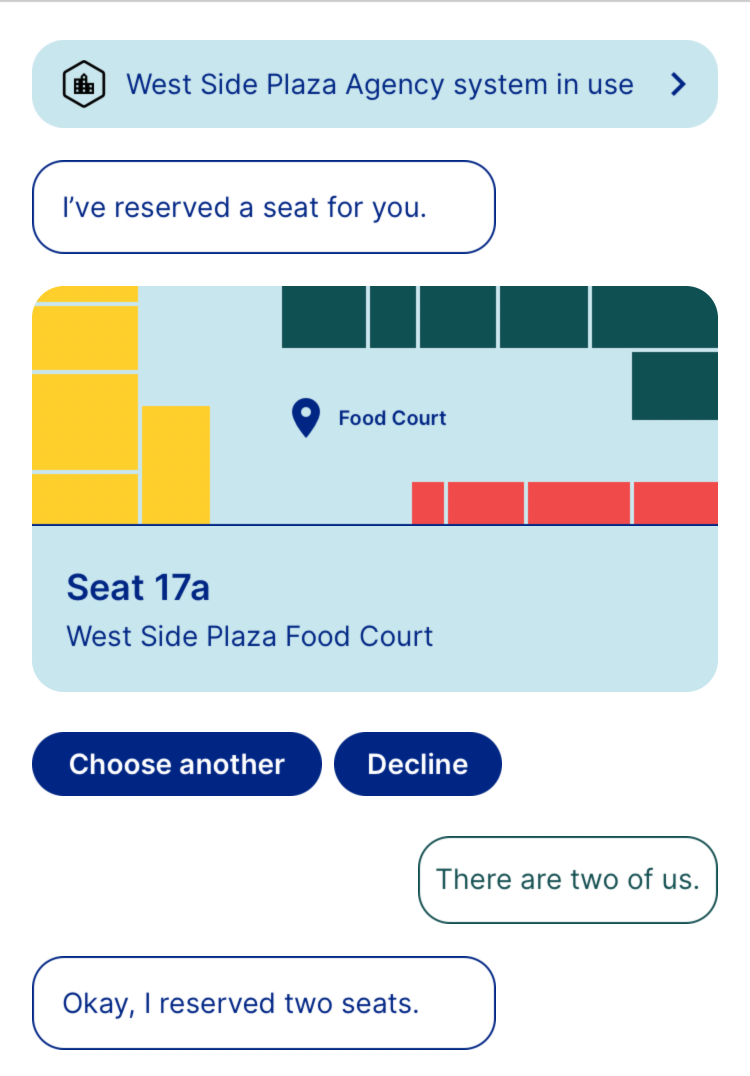
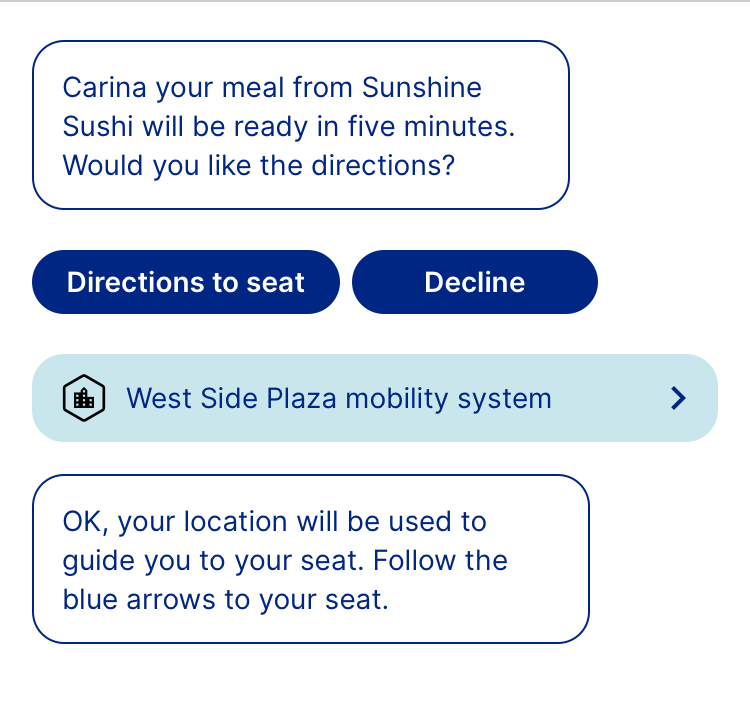
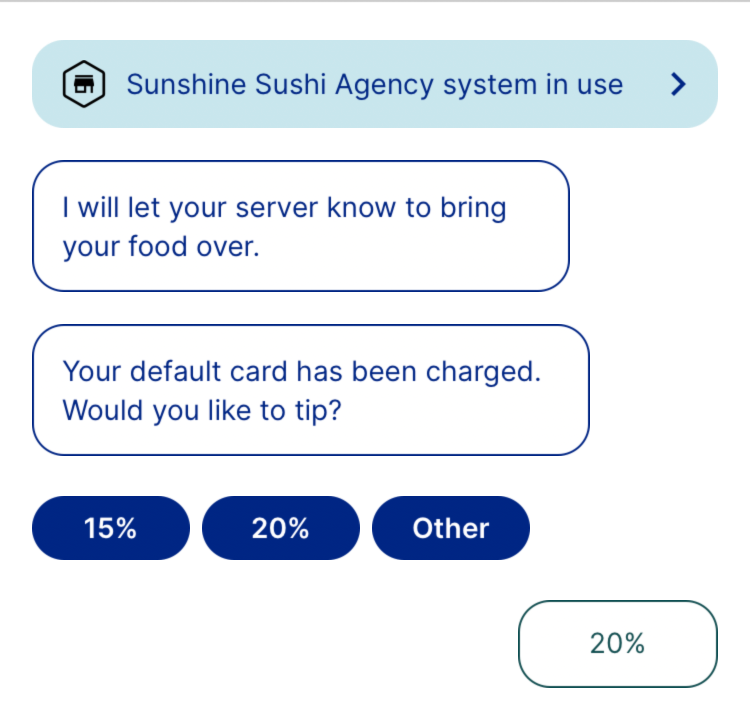
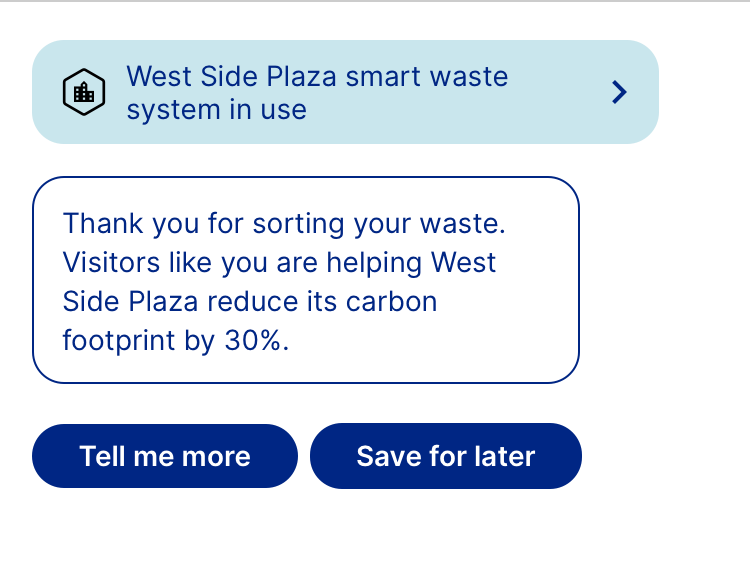
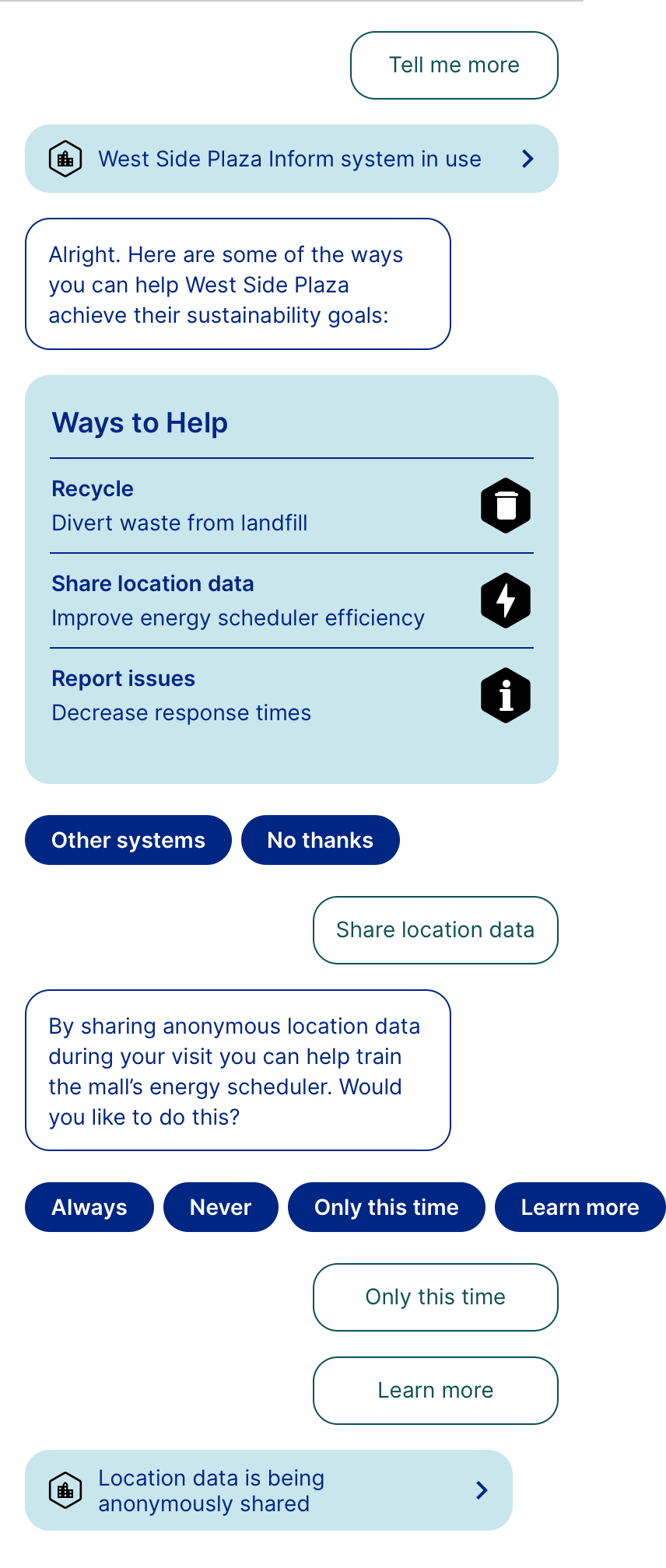
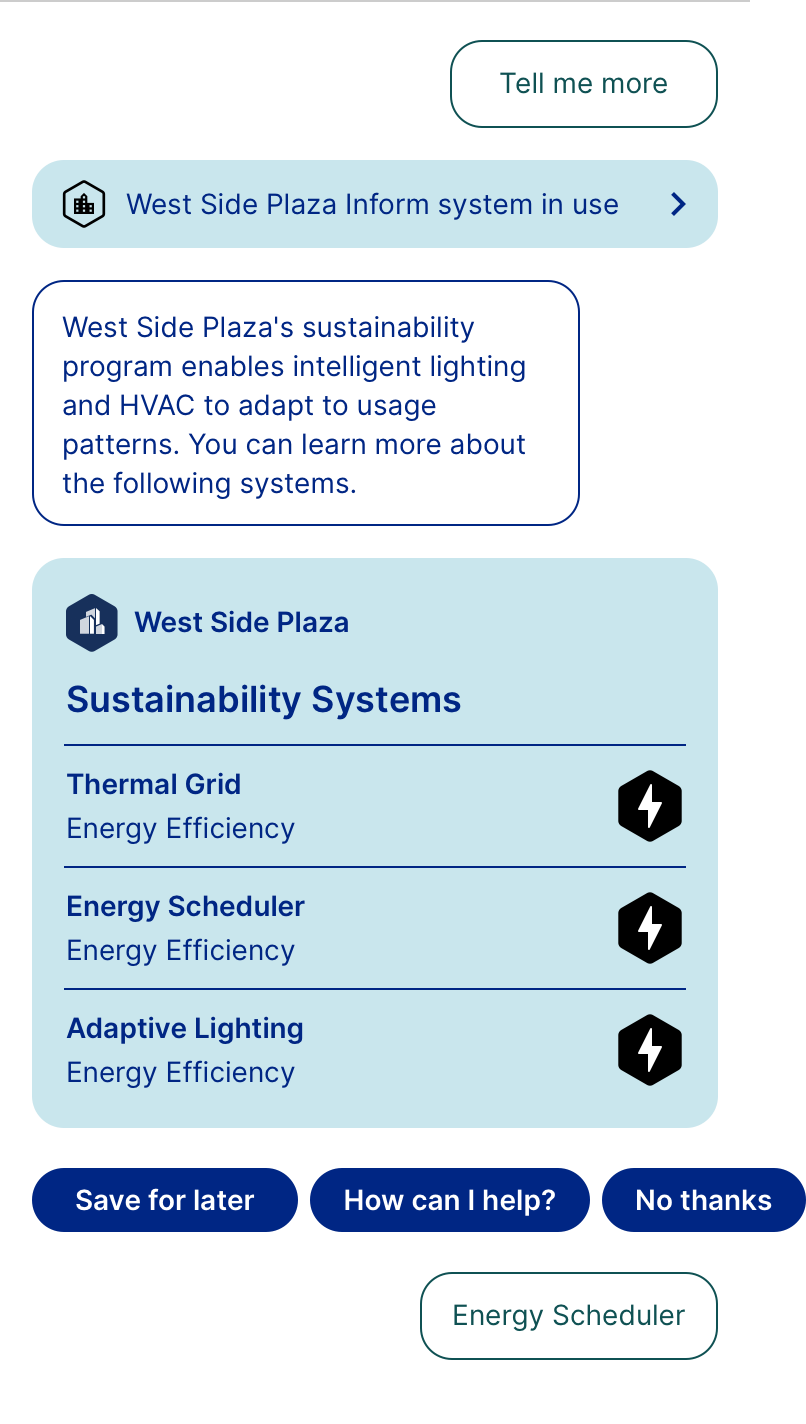
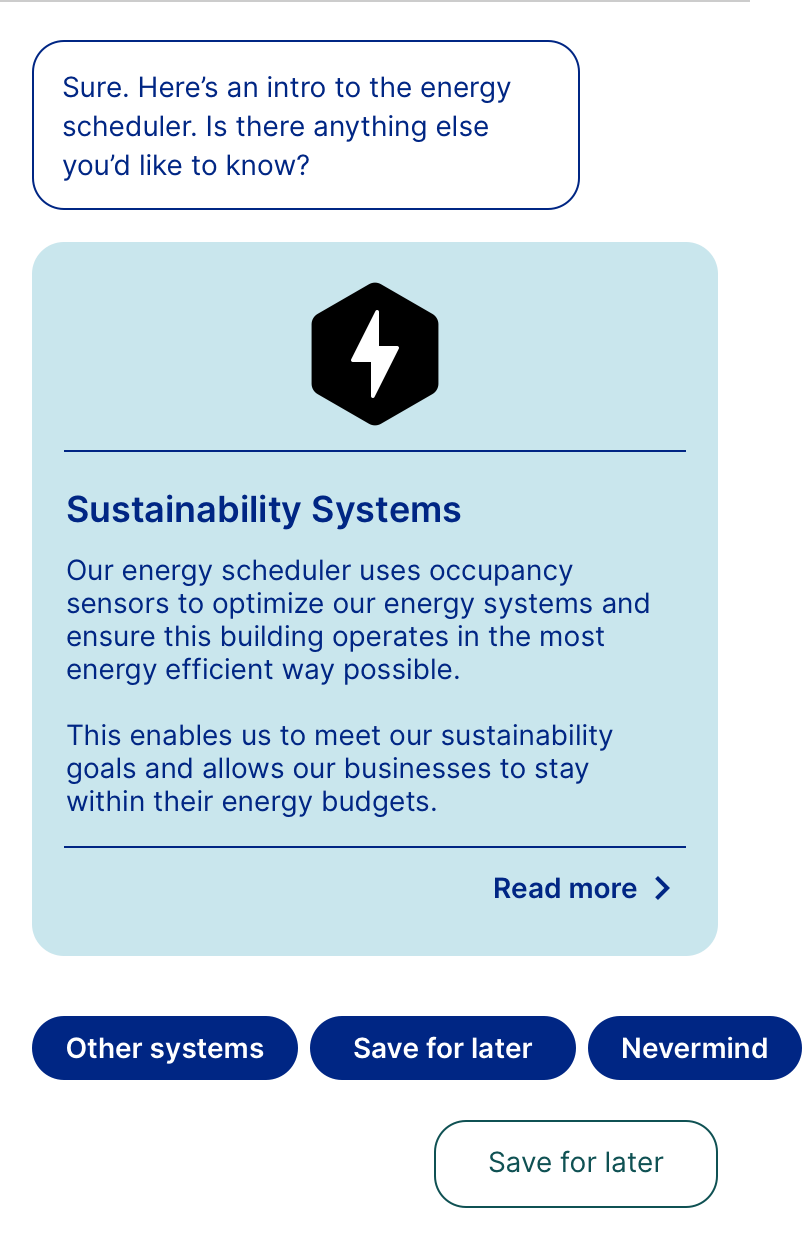
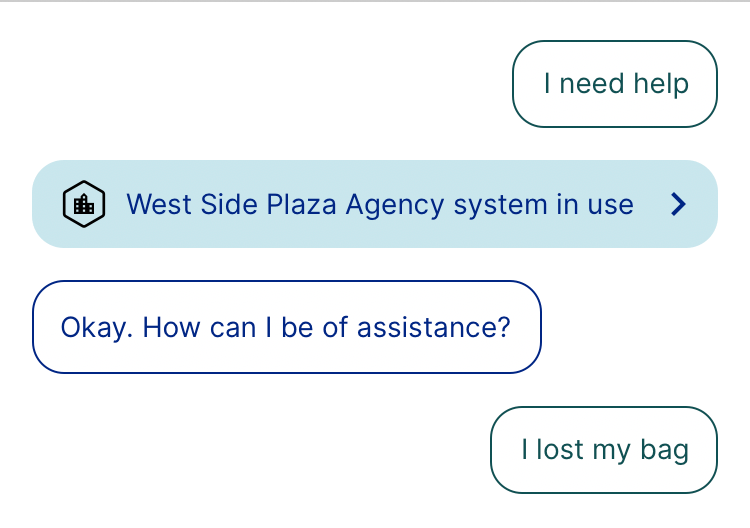
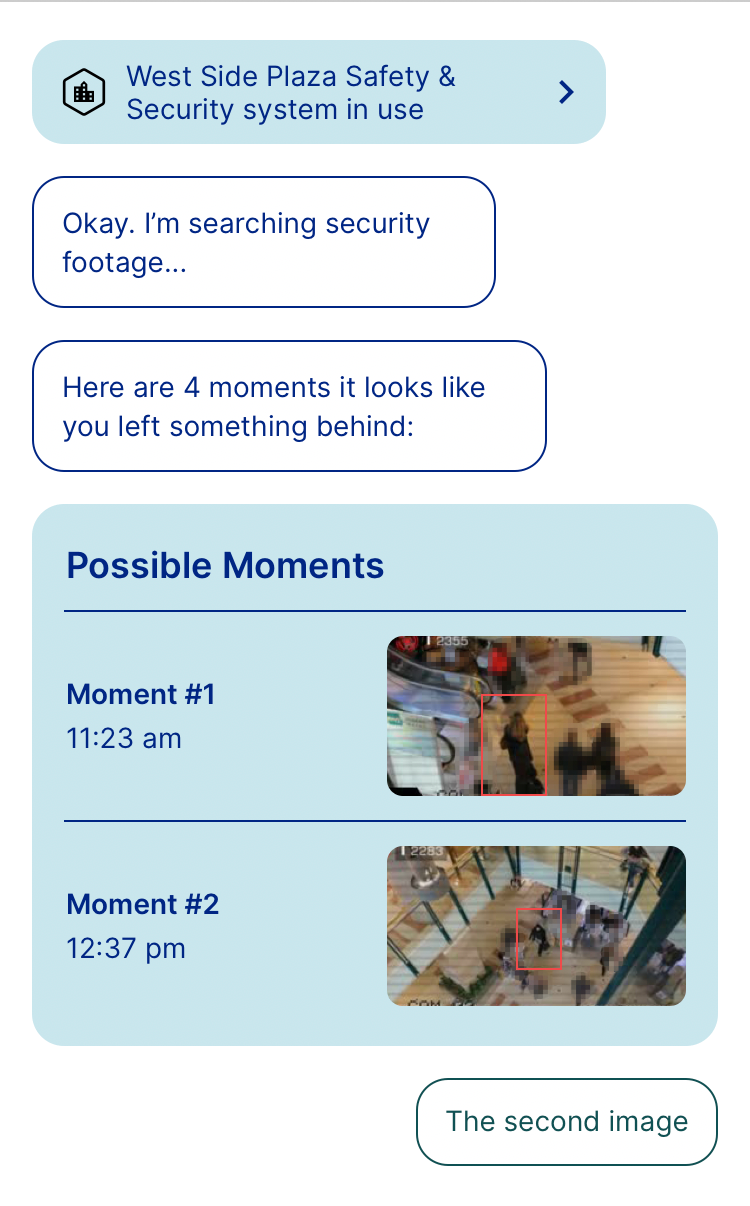
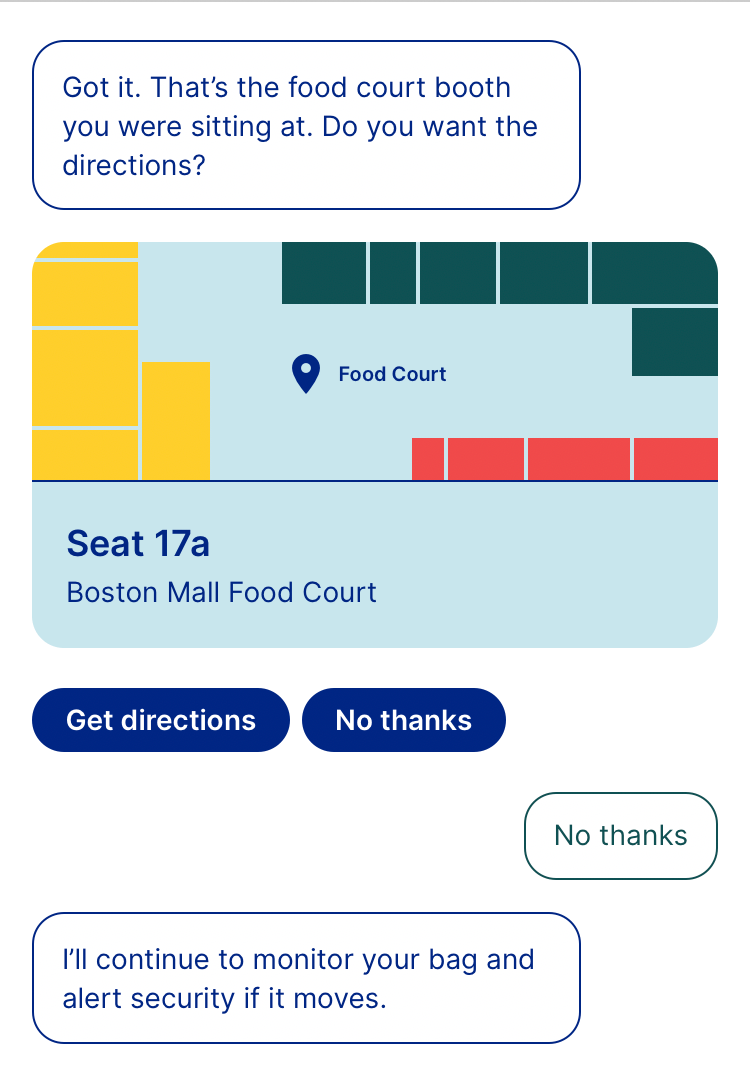
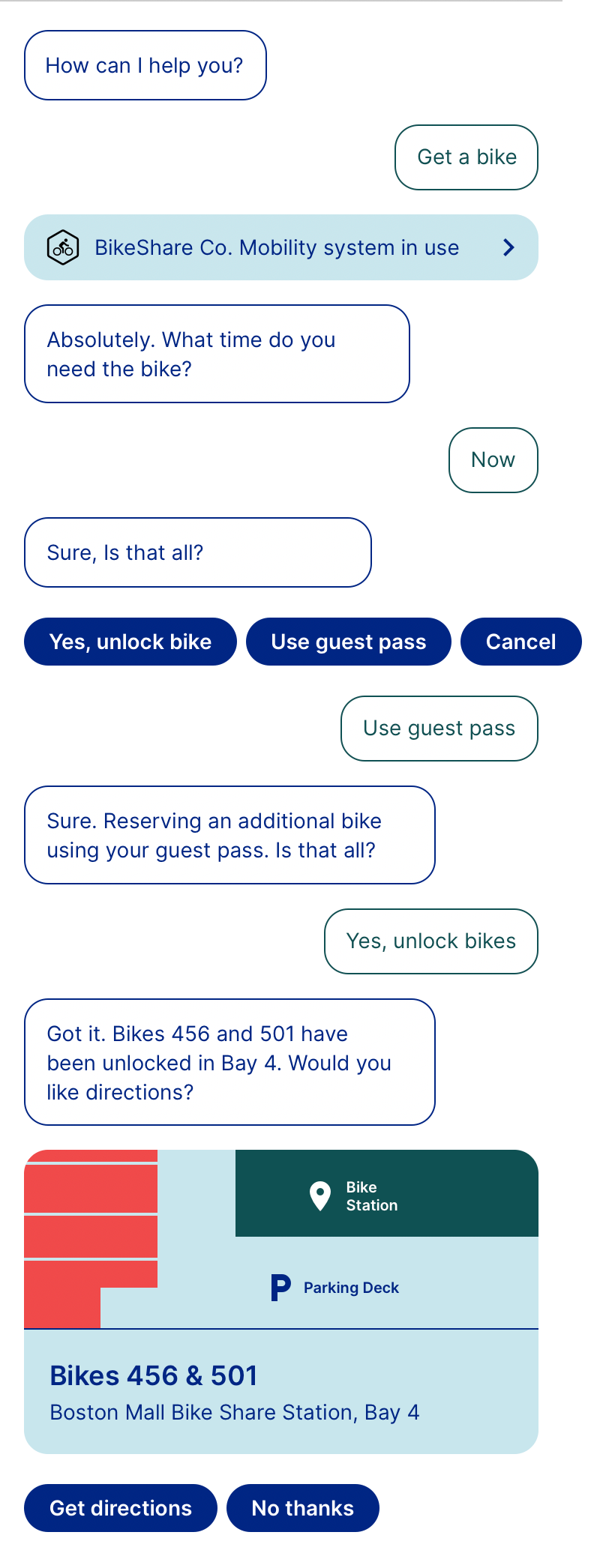
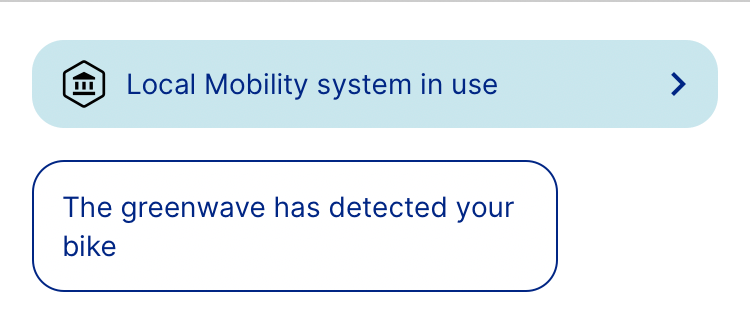
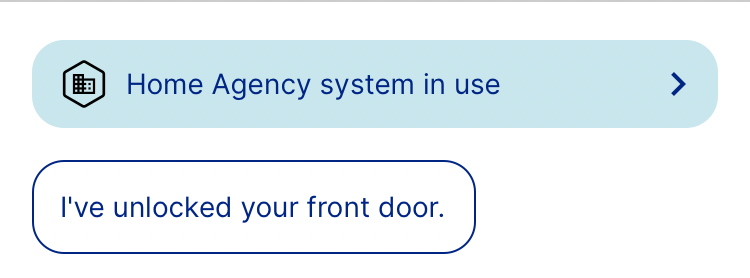
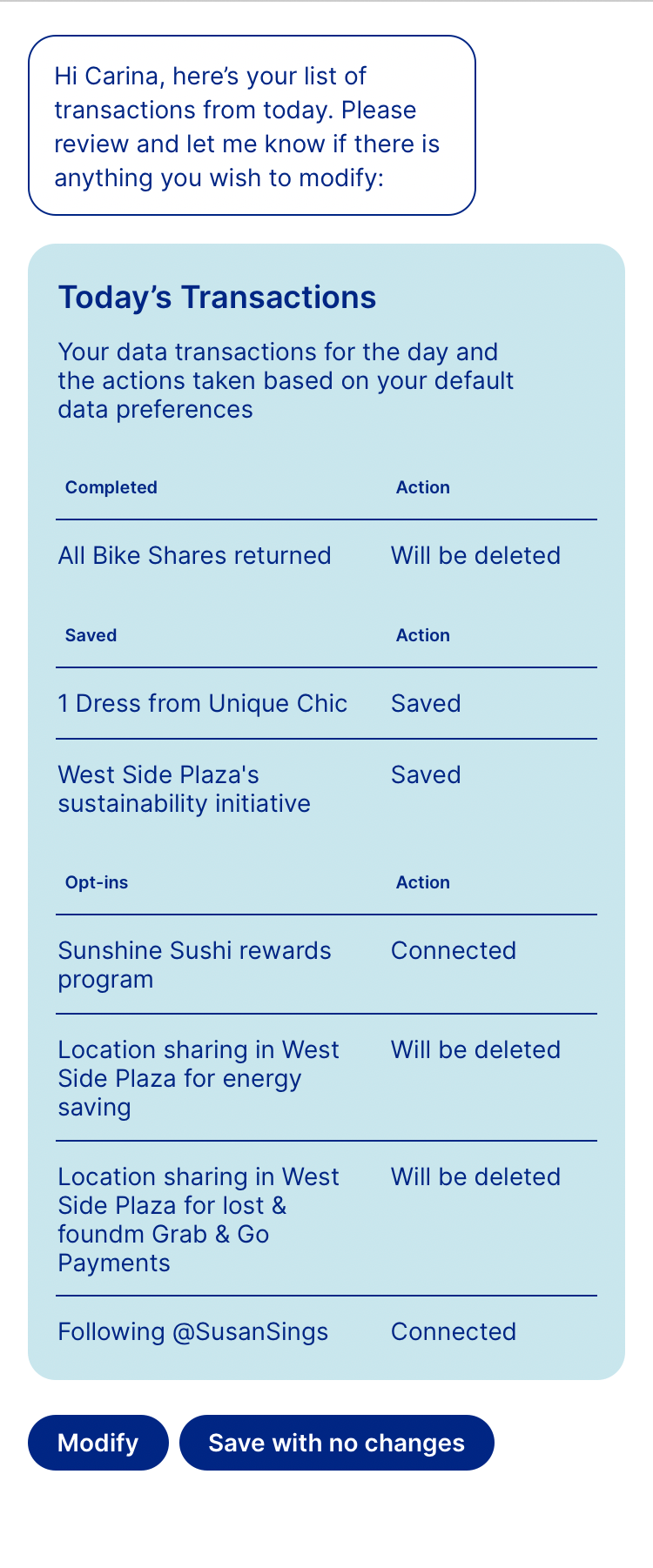
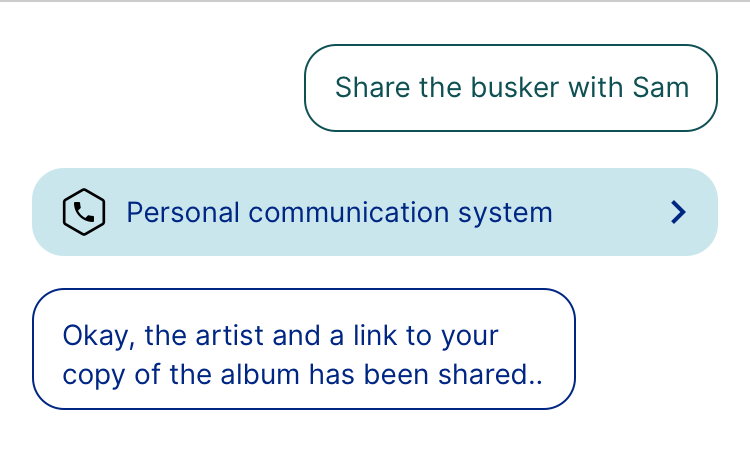























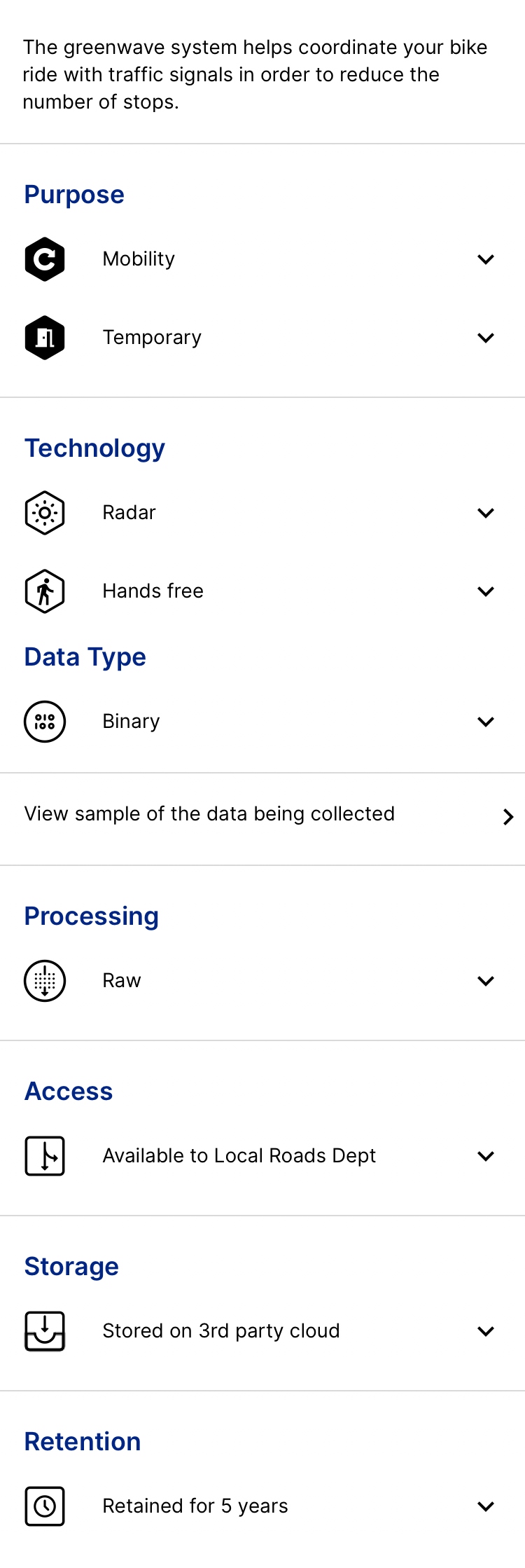



Out of the co-design sessions in early 2020 came an ask to envision how the standard might work in 5 years. Excitement built for the prospect of a personal AI assistant. This would be provided by an organization you trust. Your assistant knows your preferences and is ready to help.
In you're everyday life, you exchange data with a companies, apps, shops, and people. Everyone has different levels of comfort sharing data depending on the situation. We believe control for people can improve comfort. To ensure you maintain control of your data, these scenarios imagine a world where everyone has their own digital personal assistant.
Arriving at your destination, you dock your bike, and your session is ended. The trip is credited to your monthly membership.
The purpose of this system is
The service is provided by
The technology is
The interaction mode is
The relationship is
As you enter the plaza, you are given a link to a chatbot and can ask any questions you have about this place.
The purpose of this system is
The service is provided by
The technology is
The interaction mode is
The relationship is
You grab a book off the shelf and its added to your virtual cart. You can set these preferences with your personal AI.
The purpose of this system is
The service is provided by
The technology is
The interaction mode is
The relationship is
As you leave, the book is checked out with your library card. You continue to the street - you know you can examine the transaction later.
The purpose of this system is
The service is provided by
The user’s interface is
The relationship is
You enter a new local shop and are able to connect in the way you choose.
The purpose of this system is
The service is provided by
The technology is
The interaction mode is
The relationship is
You stand in front of the mirror. You see an option to connect and try on clothes virtually.
The purpose of this system is
The service is provided by
The technology is
The interaction mode is
The relationship is
After trying on some items, you decide to purchase one item, save a couple others to a wishlist.
The purpose of this system is
The service is provided by
The technology is
The interaction mode is
The relationship is
You bag your item, leave the store, and are given the option to create a connection with the local merchant, and change your payment method.
The purpose of this system is
The service is provided by
The technology is
The interaction mode is
The relationship is
You hear some music and follow it to the source. A busker is playing a nostalgic tune and you listen for a while.
The purpose of this system is
The service is provided by
The technology is
The interaction mode is
The relationship is
Summoning your assistant, you ask to learn more about this busker. You're able to see artist information, and even tip.
The purpose of this system is
The service is provided by
The technology is
The interaction mode is
The relationship is
The busker is presented on a shared and real-time map of this place. You can see other facilities, businesses, and those who have given you permission.
The purpose of this system is
The service is provided by
The technology is
The interaction mode is
The relationship is
You see your friend on the map, who you share your location with. You both decide to grab lunch together.
The purpose of this system is
The service is provided by
The technology is
The user’s interface is
The relationship is
You select a restaurant and your AI makes a menu suggestion. You opt-in to share your purchase data for a discount.
The purpose of this system is
The service is provided by
The technology is
The user’s interface is
The relationship is
On your way, you check the live seating status of the seating area, and choose a table.
The purpose of this system is
The service is provided by
The technology is
The interaction mode is
The relationship is
You get directions to your table and begin your stroll.
The purpose of this system is
The service is provided by
The technology is
The interaction mode is
The relationship is
After catching up with your friend, the food arrives. You have a quick chat with the server, thank them, and chow down.
The purpose of this system is
The service is provided by
The technology is
The interaction mode is
The relationship is
You get guidance from the waste bin. The compost and the recyclables are placed in the correct bins.
The purpose of this system is
The service is provided by
The technology is
The interaction mode is
The relationship is
You find out about actions you can take to help the neighbourhood achieve sustainability goals. You opt-in to sharing your anonymous location data.
The purpose of this system is
The service is provided by
The technology is
The interaction mode is
The relationship is
You can learn more about all the systems in this place or save it for later reading.
The purpose of this system is
The service is provided by
The technology is
The interaction mode is
The relationship is
You want to learn more about the occupancy sensor, you are able to ask questions about how it works, and why its important.
The purpose of this system is
The service is provided by
The technology is
The interaction mode is
The relationship is
You quickly head to a wall assistant and gesture to contact security.
The purpose of this system is
The service is provided by
The technology is
The interaction mode is
The relationship is
The security agent understands, and offers to decrypt based on 2 factor authentication using your location data.
The purpose of this system is
The service is provided by
The technology is
The interaction mode is
The relationship is
The security helps you trace your steps back to the food court, and monitors your bag until you retrieve it.
The purpose of this system is
The service is provided by
The technology is
The interaction mode is
The relationship is
After getting your bag back, you unlock 2 bikes, one for your friend, and head home together.
The purpose of this system is
The service is provided by
The technology is
The interaction mode is
The relationship is
As you wait at a light, you opt into the green wave for this journey. This considers your journey in light changes.
The purpose of this system is
The service is provided by
The technology is
The interaction mode is
The relationship is
You unlock your door with your Personal AI, and your friend can see your home data policies.
The purpose of this system is
The service is provided by
The technology is
The interaction mode is
The relationship is
Looking back, you're able to see the digital interactions you had throughout the day. You can edit them, delete some, and set future preferences.
The purpose of this system is
The service is provided by
The technology is
The interaction mode is
The relationship is
You choose to share the busker you saw with a friend.
The purpose of this system is
The service is provided by
The technology is
The interaction mode is
The relationship is